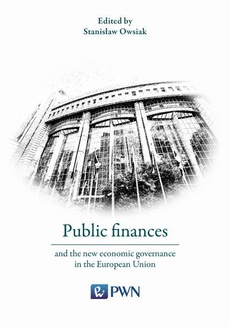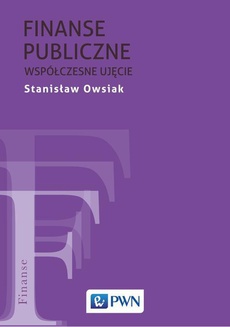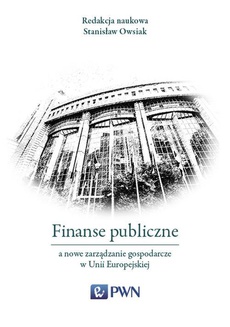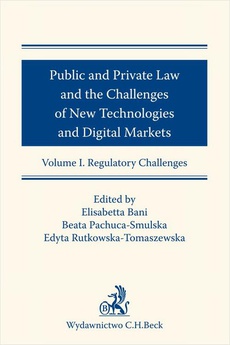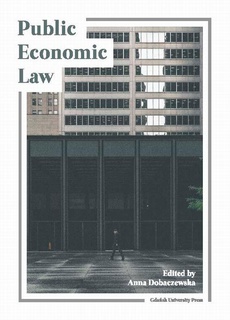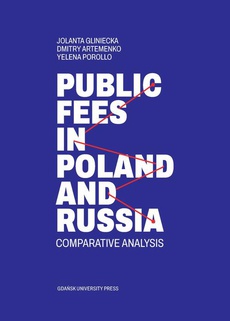INNE EBOOKI AUTORA
Public finances and the new economic governance in the European Union
Autor:
Wydawca:
Format:
epub, mobi, ibuk
This work is an attempt to assess to what extent the new economic governance of the EU helped to discipline public finances in the member states.
The poor institutional design of the EU, the authors point out, magnified the negative fiscal effects of the last financial crisis. The work attempts to examine the degree of fiscal consolidation of member states. Both, the austerity policies, as a method of consolidating public finances, and the so-called non-Keynesian fiscal policy effects have been scrutinized. Moreover, the methods of disciplining public finances in Germany, Great Britain, Hungary and Poland have been thoroughly evaluated.
The specific experience of other Member States has also been taken into account while identifying the advantages and disadvantages of current fiscal consolidation strategies. So as to examine the relationship between the budget balance and other macroeconomic variables as well as to identify changes in the economic potential of the member states and in assessing the economic convergence processes, the work relies on quantitative methods.
Prof. dr hab. Stanisław Owsiak – the long-term head of the Chair of Finance at the Faculty of Finance at the Cracow University of Economics, the holder of an honorary doctorate of the University of Szczecin, a member of the Scientific Council of the Polish Economic Society, the deputy chairman of the Committee for Economic Sciences of the Polish Academy of Sciences, a member of The Committee on Financial Sciences of the Polish Academy, member of the Economic Education Board of Narodowy Bank Polski, the chairman of the Main Committee of the Economic Knowledge Contest.
Reviewed book is the original, innovatory work which contributes to the development of finance science as well as macroeconomics. The authors shed new light on the problems of public finances in the member countries of the European Union. Application of well-chosen research methods, including quantitative methods, allowed them to discover many new dependencies and stylized facts in public finances and macroeconomics. This book is useful reading for economists, financiers, political scientists, economic sociologists, students of economic studies, journalists, politicians and for all who are interested in economics and finance.
Prof. dr hab. Sławomir I. Bukowski
Kazimierz Pułaski University of Technology and Humanities in Radom
| Rok wydania | 2018 |
|---|---|
| Liczba stron | 532 |
| Kategoria | Finanse i bankowość |
| Wydawca | Wydawnictwo Naukowe PWN |
| ISBN-13 | 978-83-01-19916-6 |
| Język publikacji | polski |
| Informacja o sprzedawcy | ePWN sp. z o.o. |
POLECAMY
Ciekawe propozycje
Spis treści
| Introduction | 11 |
| Chapter 1. Practical dimension of research on public finances | 17 |
| 1. Premises for disciplining public finances in the European Union | 19 |
| 2. Measures undertaken by the European Union to discipline public finances | 22 |
| 3. Research thesis | 25 |
| 4. Verification methods | 27 |
| 4.1. A qualitative and quantitative approach | 27 |
| 4.2. Fiscal consolidation as the basic tool for disciplining public finances | 29 |
| 4.3. Budget balance and types of fiscal policy | 31 |
| 4.4. Methods of examining the relationship between budget balance and macroeconomic variables | 33 |
| 4.5. The matter of non-Keynesian effects of fiscal policy during the crisis | 35 |
| 4.6. Method for testing the economic potential of EU countries | 36 |
| 4.7. Convergence or economic divergence in Europe | 37 |
| 5. Time scope of the study | 38 |
| 6. Country selection criteria – case studies | 40 |
| Chapter 2. Concepts of fiscal consolidation | 45 |
| 1. Definitional difficulties | 47 |
| 2. Controversies over the concept of fiscal consolidation | 48 |
| 2.1. Problem of the starting point of consolidation | 48 |
| 2.2. Choice of consolidation strategy and macroeconomic effects | 50 |
| 2.3. Measuring consolidation | 53 |
| 2.4. Criteria for assessing the effects of consolidation | 55 |
| 3. Dilemma regarding the choice of consolidation instruments | 55 |
| 4. Assessing the sustainability of fiscal consolidation in selected EU countries | 59 |
| 5. Summary | 63 |
| Chapter 3. Fiscal supervision as an element of new economic governance in the European Union | 65 |
| 1. Treaty bases for coordination of the Member States’ economic and budgetary policies | 67 |
| 2. Evolution of fiscal supervision 1992–2005 | 71 |
| 3. Fiscal supervision as an element of new economic governance | 77 |
| 3.1. General concept of change | 77 |
| 3.2. New requirements for budgetary frameworks of member states | 81 |
| 3.3. Action undertaken to strengthen the surveillance of budgetary positions and the surveillance and coordination of economic policies | 83 |
| 3.4. Action to speed up and clarify the excessive deficit procedure | 87 |
| 3.5. Enforcement of budgetary surveillance in the euro area | 90 |
| 3.6. Mechanism for preventing and correcting macroeconomic imbalances | 91 |
| 3.7. Enforcement of correction of excessive macroeconomic imbalances in the euro area | 94 |
| 4. Further attempts to strengthen fiscal supervision | 95 |
| 4.1. The Fiscal Compact | 95 |
| 4.2. ‘The two-pack’ | 97 |
| 5. Assessment of the reform of the economic governance in the EU | 102 |
| 6. Conclusion | 114 |
| Chapter 4. Austerity as a tool of fiscal consolidation – theoretical and empirical perspective | 115 |
| 1. Introduction | 117 |
| 2. Historical debate | 122 |
| 3. Neoliberalism and financialization | 128 |
| 4. Macroeconomic performance | 131 |
| 5. The justification for austerity | 136 |
| 6. Economic crisis and fiscal policy | 143 |
| 7. The ideological foundations of supply side economics | 153 |
| 8. Brexit and its implications for the UK | 161 |
| 9. Conclusion | 164 |
| Chapter 5. Efforts of fiscal consolidation in the United Kingdom | 167 |
| 1. Introduction – background of the study | 169 |
| 1.1. The sovereign debt crisis and financial stability | 171 |
| 1.2. The United Kingdom’s Fiscal Stability Code | 171 |
| 1.3. The Maastricht Treaty and fiscal rules | 172 |
| 2. The pre-crisis overview | 175 |
| 2.1. Macroeconomic imbalances in the UK | 175 |
| 2.2. State of public finances before the crisis | 178 |
| 2.3. Budgetary forecast before the crisis | 179 |
| 3. Analysis of the financial crisis period | 180 |
| 3.1. Public sector net debt | 182 |
| 3.2. Relative projections and economic performances | 183 |
| 3.3. Output gap and real GDP | 185 |
| 3.4. The structural deficit | 186 |
| 4. Efforts of fiscal consolidation | 188 |
| 4.1. Policy implementation under Labour government | 188 |
| 4.2. Policy changes under coalition government | 189 |
| 4.3. Policy effects on the UK economy | 192 |
| 4.4. The UK’s public finances and Brexit | 194 |
| 4.4.1. The mechanical effect | 194 |
| 4.4.2. The national income effect | 195 |
| 5. The policy decision and summary | 196 |
| Chapter 6. Fiscal consolidation in the Federal Republic of Germany | 199 |
| 1. Characteristics of fiscal policy in the Federal Republic of Germany 1999–2007 | 201 |
| 2. Reforms in the public expenditure system | 217 |
| 3. Changes in the public revenue system in the years 1999–2007 | 220 |
| 4. Characteristics of fiscal policy in the Federal Republic of Germany 2008–2015 | 224 |
| 4.1. State interventionism in response to the crisis: 2008–2010 | 224 |
| 4.2. Savings policy implemented by the Federal Republic of Germany in 2011–2015 | 231 |
| 5. German fiscal policy and the business cycle | 235 |
| 6. The problem of common monetary policy | 242 |
| 7. Socio-economic effects of the fiscal policy of the Federal Republic of Germany | 247 |
| 8. Summary | 252 |
| Chapter 7. Fiscal consolidation strategies in Hungary | 255 |
| 1. Introduction | 257 |
| 2. Excessive deficit in Hungary and scenarios for its correction | 258 |
| 3. Medium-term budgetary objective | 264 |
| 4. Public debt in Hungary | 266 |
| 5. Instruments for disciplining public finances on the expenditure side | 269 |
| 6. Scenarios of expenditure adjustments and their implementation | 272 |
| 7. Instruments for disciplining public finances on the revenue side | 276 |
| 8. Scenarios of revenue adjustments and their implementation | 281 |
| 9. Institutional changes favouring fiscal consolidation | 288 |
| 10. Evaluation of fiscal consolidation | 289 |
| 11. Economic effects of fiscal consolidation | 292 |
| 12. Macroeconomic imbalances in Hungary in the period of fiscal consolidation attempts | 299 |
| 12.1. Internal imbalances | 299 |
| 12.2. External imbalances | 302 |
| 13. Conclusions | 303 |
| Chapter 8. Strategies of fiscal consolidation in Poland | 305 |
| 1. Introduction | 307 |
| 2. Fiscal consolidation in Poland in 2003–2008 | 308 |
| 2.1. Adaptation measures to the nominal fiscal convergence criterion | 308 |
| 2.2. Changes on the revenue side of government institutions sector and local government | 320 |
| 2.3. Actions to reduce public spending | 323 |
| 3. Impact of 1999 pension reform on the condition of public finances in the period 2004–2015 | 329 |
| 4. Fiscal policy in Poland in response to the global financial and economic crisis | 338 |
| 4.1. New solutions adopted in the Public Finance Act of 2009 | 338 |
| 4.2. Disciplining public finances in Poland after launching the excessive deficit procedure in 2009 | 344 |
| 5. Summary | 358 |
| Chapter 9. Testing the dynamic relationships between the public financial sector deficit and the macroeconomic variables in selected EU countries | 361 |
| 1. Description of the testing procedure | 363 |
| 2. Dynamic modelling results in selected EU economies | 366 |
| 2.1. Poland | 369 |
| 2.2. The United Kingdom | 371 |
| 2.3. Hungary | 371 |
| 2.4. Germany | 373 |
| 2.5. France | 374 |
| 2.6. Sweden | 375 |
| 3. Analysis of the impulse response function | 377 |
| 4. The results of Granger causality test | 383 |
| 5. Summary | 386 |
| Annex | 387 |
| Chapter 10. The impact of the financial crisis on the distribution of total power across the member states of the European Union | 395 |
| 1. Introduction | 397 |
| 2. The measurement of power and its distribution in the European Union | 399 |
| 2.1. The applicability of the power model and its core components | 399 |
| 2.2. The distribution of power in the European Union | 406 |
| 2.3. Total power and stability at the onset of the recession in the EU | 410 |
| 3. Shifts in the stability of total power | 413 |
| 3.1. The position during the recession | 413 |
| 3.2. The position after the recession | 418 |
| 3.3. Economic potential and public spending in the Baltic states | 421 |
| 4. The impact of the crisis on the Baltic states and their fiscal responses | 422 |
| 4.1. Changes in GDP output from 2006 to 2014 | 422 |
| 4.2. Changes in the structure of total power and its causes – Poland and the Baltic states | 424 |
| 4.3. Drivers of growth and debt compared | 427 |
| 5. Conclusion | 429 |
| Chapter 11. Process of economic convergence of European countries | 433 |
| 1. Initial remarks | 435 |
| 2. Models for cross-section and time-series variables configuration | 436 |
| 3. Methods for stratified analysis | 441 |
| 4. Initial analysis of GDP per capita ratios variation in European countries in 1950–2015 | 444 |
| 5. Analysis of moveable dynamics indexes for GDP per capita ratios in European countries | 449 |
| 6. Analysis of the ranking of European countries by GDP per capita ratios in selected years | 452 |
| 7. Summary | 457 |
| Chapter 12. Options for disciplining public finances – synthesis | 459 |
| 1. Condition of public finances as a result of various factors | 461 |
| 2. Assessment of the impact of fiscal stimulus on public finances in the European Union countries | 462 |
| 3. Convergence or divergence – research results | 467 |
| 4. Case study on the assessment of disciplining public finances in the surveyed countries | 468 |
| 5. Evaluation of fiscal consolidations | 486 |
| 6. Evaluation of the role of new public governance in disciplining public finances | 493 |
| 7. Variants for achieving public finance discipline – conclusions for Poland | 498 |
| Annex | 503 |
| Bibliography | 509 |

